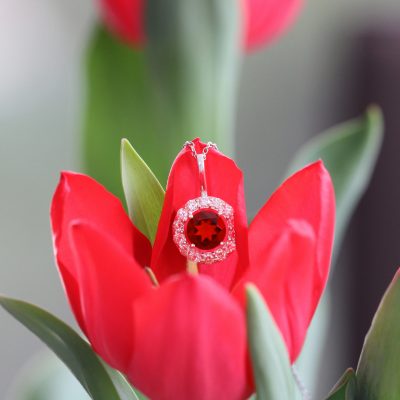
Every birthstone has its own meaning. July’s birthstone, the radiant ruby, is associated with love, passion, life and heat. And as we hit the middle of July and the height of summer, we are reminded that the rich color of the ruby is perfectly suited for summertime heat. This stunning gem is one of the four precious gemstones and would look superb as a princess cut ring, in a bezel setting, as a marquise-cut ring, in a pave setting and in so many other delightful, alluring designs.
There is a lot more to this extraordinary gemstone than just its remarkable beauty, though. Let’s take a look at these 10 fascinating facts about the “King of Gems”, the ruby.
The King of Gems
- Ruby means red: The word ‘ruby’ comes from the Latin word ‘rubens’, which means red.
- Like a sapphire: The same mineral that makes up sapphires, corundum, makes up the ruby. The only real difference between them is their color. Rubies, of course, have that deep, rich, luxurious red for which they are famous. Sapphires, while mostly known for their royal blue color, also come in a variety of other colors.
- The ruby’s amazing color: Those famous luxurious ruby reds come in a range of shades, from rich darkish red to pigeon blood red and pinkish red.
- Lab-grown rubies are real rubies: There are also lab-grown rubies (aka synthetic, created, or cultured) that from a chemical standpoint, are not different from natural rubies. Thus, they are considered real rubies (and should not be confused with fake rubies). However, natural and synthetic rubies do differ in structure and this difference can be seen if they are viewed under a microscope.
- Lab-grown vs. natural rubies: Lab-grown rubies provide a more affordable option for people who have their heart set on ruby jewelry, but can’t quite meet the price tag. They are quite lovely and to the naked eye and there is no discernable difference between natural and lab-grown rubies. Similar to choosing between natural and lab-grown diamonds, your choice between a natural ruby and a lab-grown ruby will depend on your budget and preferences.
- Are pink sapphires rubies? Although they are sometimes confused, pink sapphires and rubies are not the same. According to gemsociety.org, a ruby is a red corundum and the presence of chromium is what makes the ruby or corundum gemstone red. All other varieties of corundum, except of course the red ones, are sapphires.
- Inclusions, good or bad? Inclusions in rubies, unlike other gemstones, are thought to enhance a ruby’s beauty and make it look more intriguing and satiny.
- Why rubies glow: When exposed to sunlight, UV rays from the sun make the chromium inside the ruby glow. This is what gives rubies that special glowing property.
- Burmese rubies: The majority of the highest quality rubies come from Myanmar, which was once called Burma. This is why these rubies are sometimes referred to as Burmese rubies.
- Almost as durable as diamonds: Rubies are extremely strong and register 9 on the Mohs scale of hardness. They are only slightly softer than diamonds. Its durability makes it a gorgeous choice for any jewelry piece.
By-the-way, it’s also traditional to give rubies for 15th and 40th wedding anniversaries. But do you really need a reason?

Round ruby stone in a flower design with two diamond marquis stones on each side of the leaf’s branches.

Classic oval ruby cluster engagement ring
Modern bracelet with mixed ruby gemstones set in yellow gold
Marquise ruby anniversary ring

